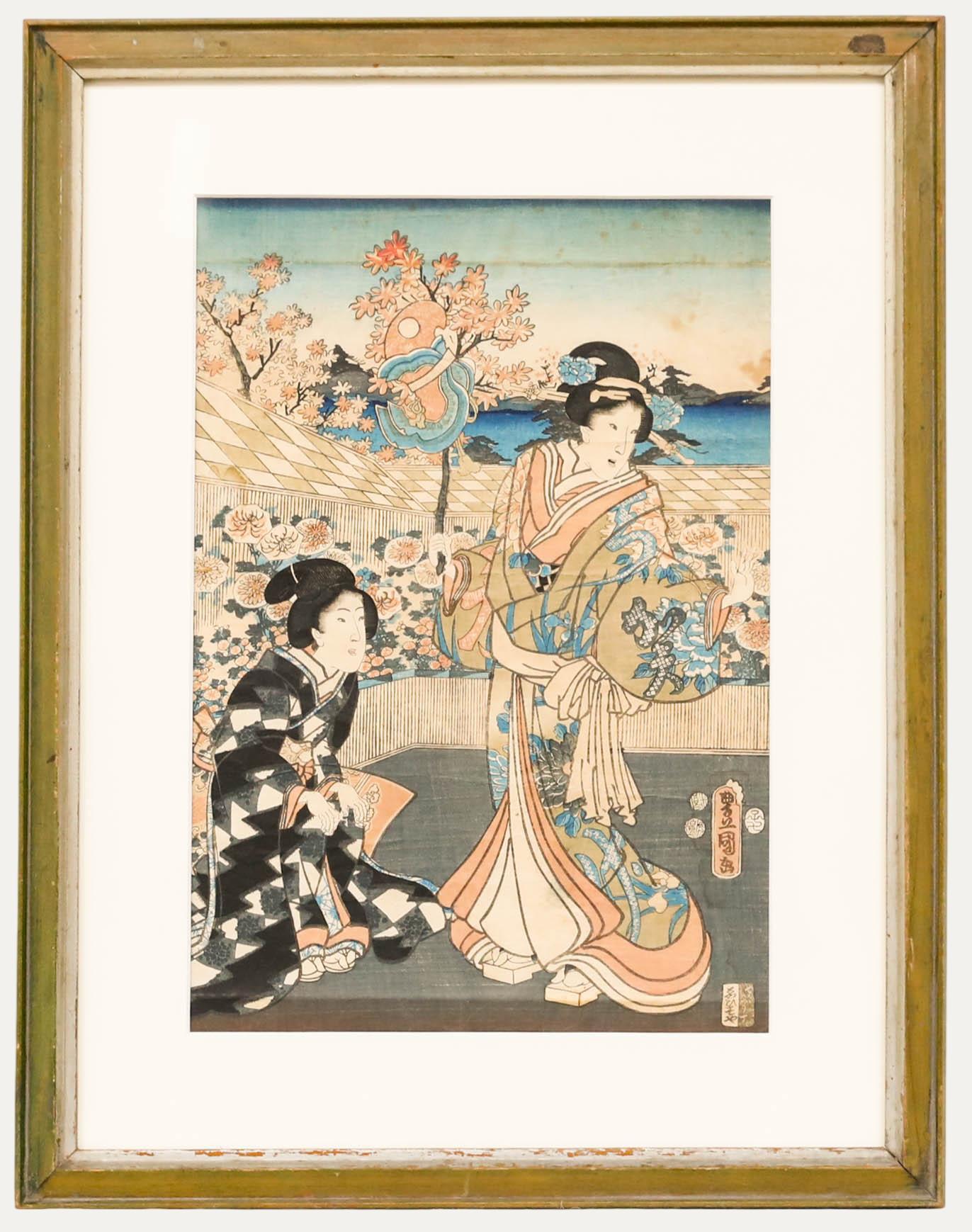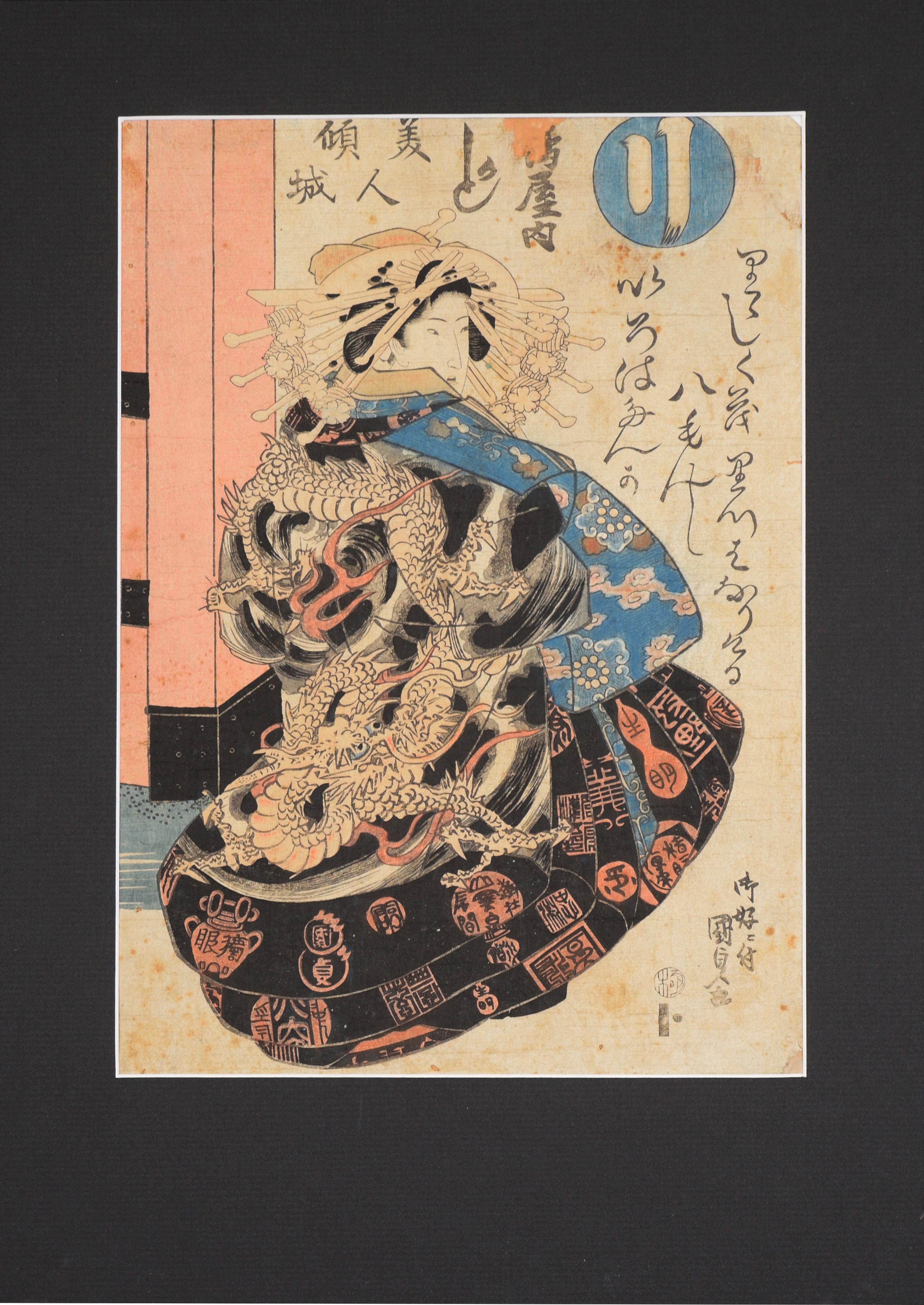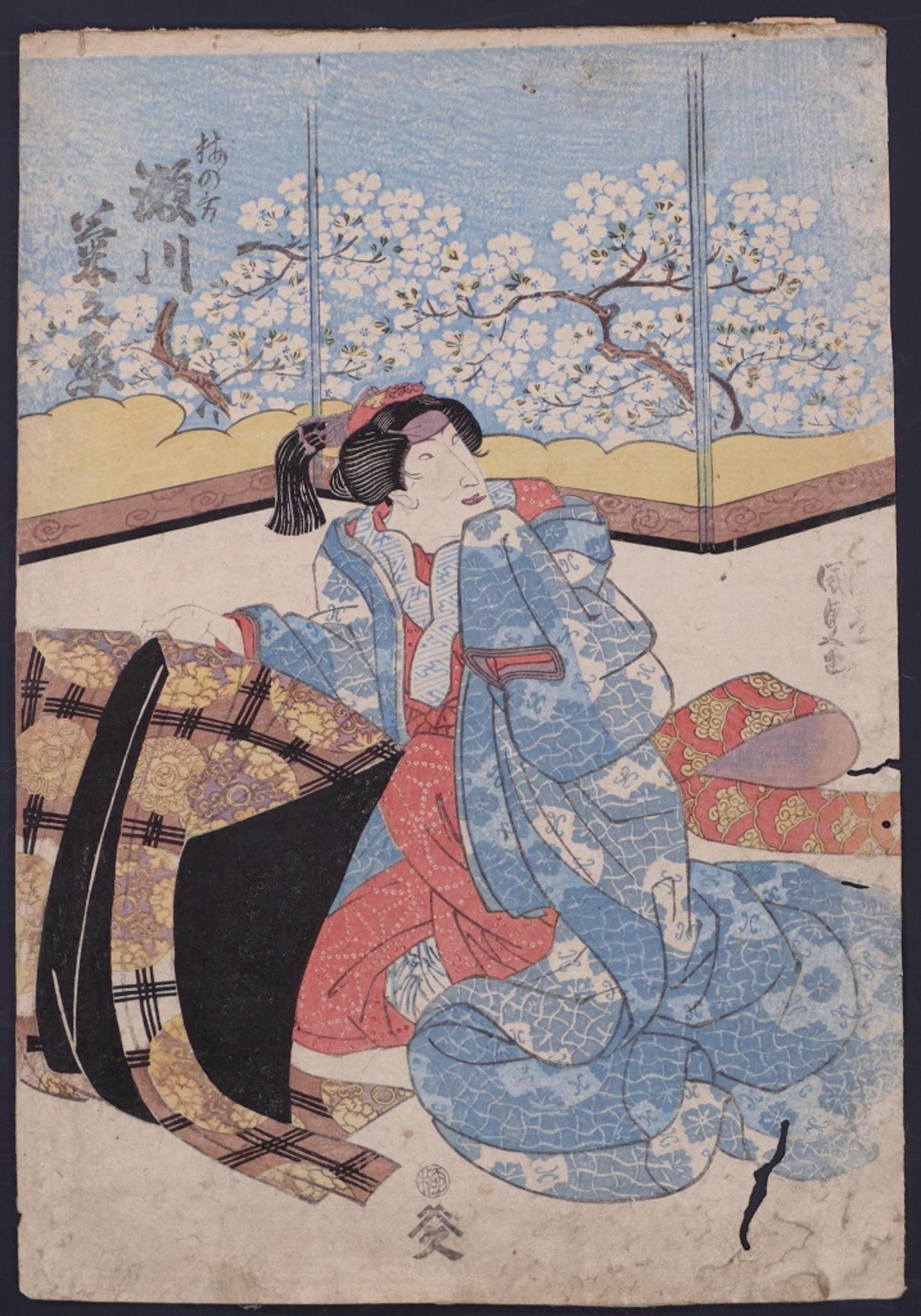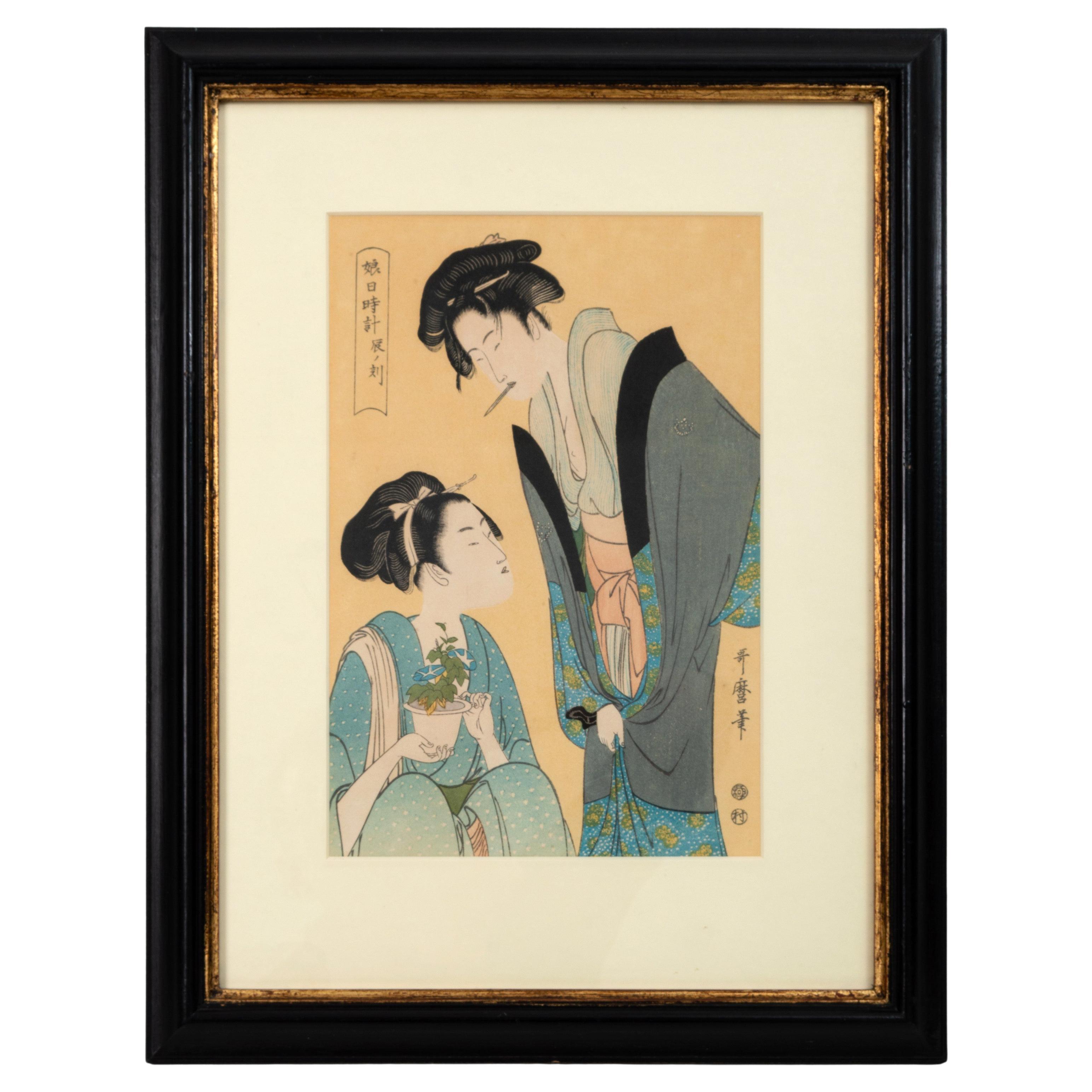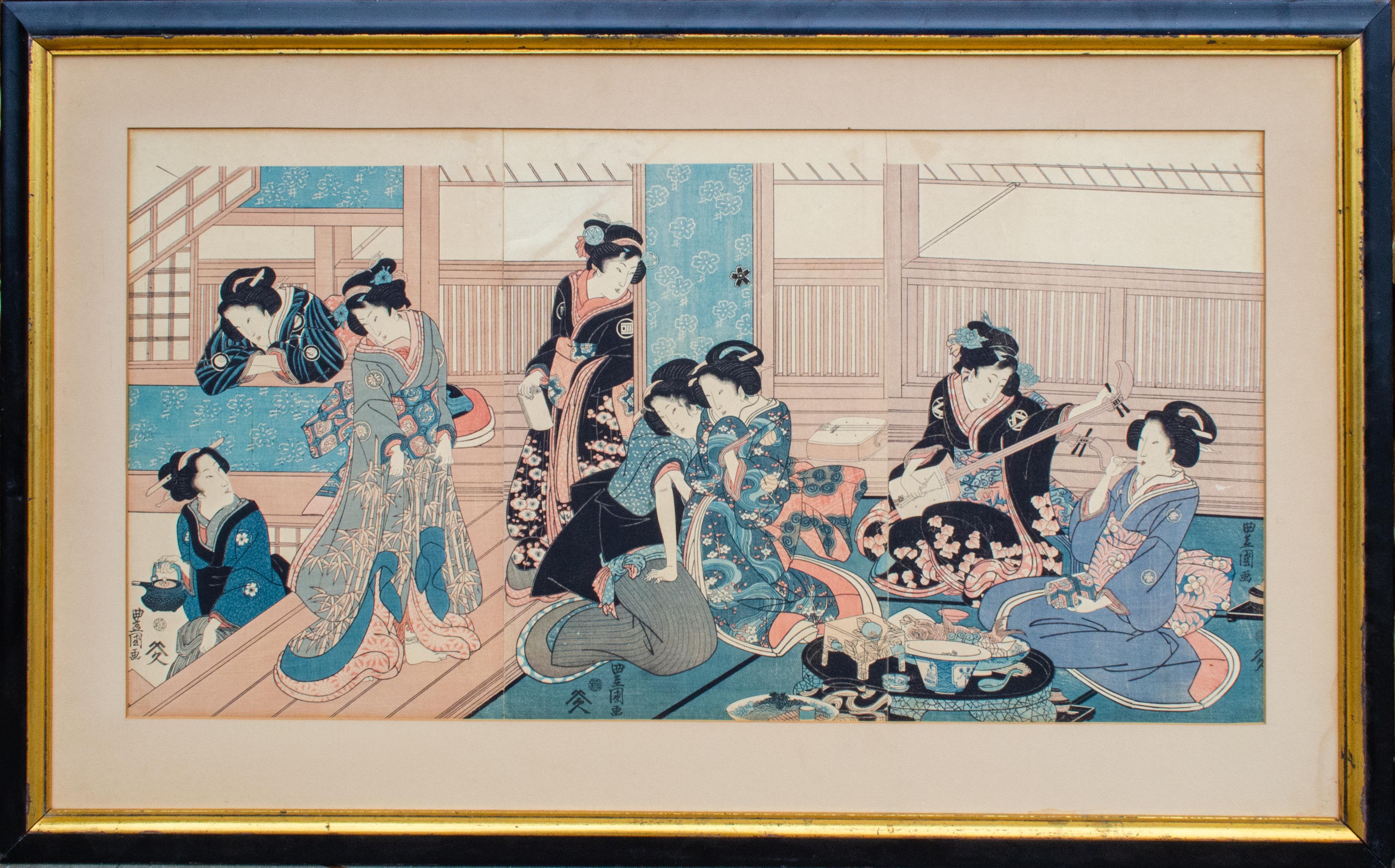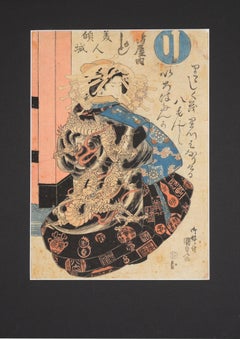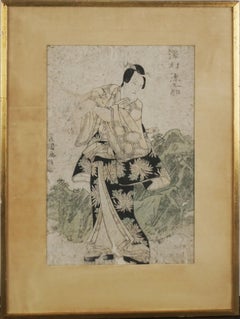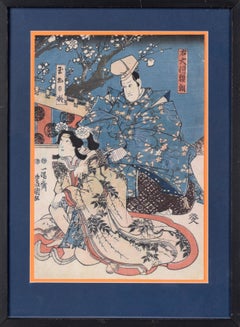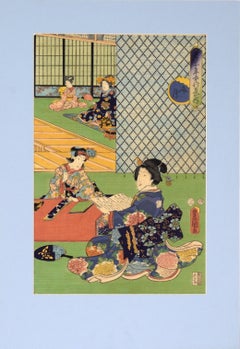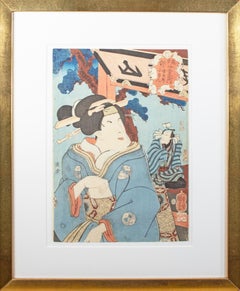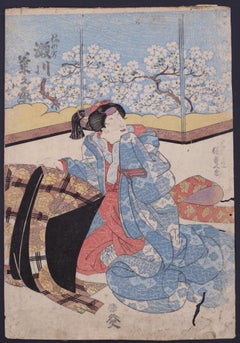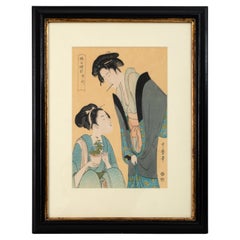Items Similar to Courtesans at Yoshiwara Edomachi - Figurative Japanese Woodblock Print on Paper
Want more images or videos?
Request additional images or videos from the seller
1 of 14
Utagawa YoshiikuCourtesans at Yoshiwara Edomachi - Figurative Japanese Woodblock Print on Paperlate 19th Century
late 19th Century
$675
£520.07
€594.08
CA$966.38
A$1,054.03
CHF 554.20
MX$12,648.85
NOK 6,997.38
SEK 6,526.65
DKK 4,436.91
About the Item
Courtesan at Yoshiwara Edomachi - Figurative Japanese Woodblock Print on Paper
Full color woodcut print of two women in elaborate gowns by Utagawa Yoshiiku (Ochiai Yoshiiku) (Japanese, 1833-1904). Two women are dressed in colorful robes with crossed arms. They are underneath a plum blossom tree in bloom, at night. In the background there is a building with many rooms. Valuable polychrome woodblock print of vertical large oban (大判) format made by Utagawa Yoshiiku (歌川芳幾), the famous artist also known as Ochiai Yoshiiku (落合芳幾), and depicting the courtesan Shizuka (しづか), of the house of pleasure Matsumotoro (松本楼), together with her young kamuro (禿) assistant. The couple is escorted by a kanabohiki (金棒引き) watchman holding a lantern and a metal rod with rings to make noise and alert the crowd.
The work, produced in August 1869 by the publisher Tsunajima Kamekichi (綱島亀吉), is taken from the “Twelve Months of Yoshiwara” (よし原十二ヶ月のうち), an elegant series of prints dedicated to the famous red light district of Edo (江戸), and is paired with the “month of leaves” Hazuki (葉月), that is August.
Ochiai Yoshiiku (Japanese, 1833-1904) was an ukiyo-e artist from the end of the Edo Period to the Meiji Period. He has created works which are essential to the history of ukiyo-e, such as“Twenty-eight Famous Murders with Verse”, a series of chimidoro-e (bloody paintings) which Yoshiiku and Tsukioka Yoshitoshi collaborated together, and “Shimbun (newspaper) Nishiki-e” that illustrated Meiji news articles with ukiyo-e.
Born the son of teahouse proprietor Asakusa Tamichi in 1833, Yoshiiku became a student of ukiyo-e artist Utagawa Kuniyoshi toward the end of the 1840s. His earliest known work dates to 1852 when he provided the backgrounds to some actor prints by his master.
Yoshiiku's earliest works were portraits of actors (yakusha-e), beauties (bijin-ga), and warriors (musha-e). He later followed Kuniyoshi into making satirical and humorous pieces, and became the leading name in the field after Kuniyosh's death in 1861. He illustrated the Tokyo Nichi Nichi Shimbun ("Tokyo Daily News") from 1874 to 1876, and then co-founded the Tokyo E-iri Shinbun ("Tokyo Illustrated News"). The latter folded in 1889, and Yoshiiku returned to making prints. He struggled during his last years, and his last known print appeared in 1903.
- Creator:Utagawa Yoshiiku (1833 - 1904)
- Creation Year:late 19th Century
- Dimensions:Height: 21.5 in (54.61 cm)Width: 16.5 in (41.91 cm)Depth: 0.5 in (1.27 cm)
- Medium:
- Movement & Style:
- Period:
- Condition:Very good. Some tonal ageing to paper, as expected. Ink is vibrant and saturated.
- Gallery Location:Soquel, CA
- Reference Number:Seller: DBH86271stDibs: LU54212400052
About the Seller
5.0
Platinum Seller
Premium sellers with a 4.7+ rating and 24-hour response times
Established in 1986
1stDibs seller since 2014
3,046 sales on 1stDibs
Typical response time: <1 hour
- ShippingRetrieving quote...Shipping from: Soquel, CA
- Return Policy
More From This Seller
View AllThe Courtesan Kashiwagi and the Kamuro Wakano - Japanese Woodblock Print
By Utagawa Kunisada (Toyokuni III)
Located in Soquel, CA
The Courtesan Kashiwagi and the Kamuro Wakano - Japanese Woodblock Print
Original Toyokuni III/Kunisada (Japanese, 1786 - 1864) Japanese Woodblock Print
"The Courtesan Kashiwagi and...
Category
1820s Realist Figurative Prints
Materials
Printer's Ink, Rice Paper, Woodcut
Kabuki Actor in Water Lily Robe with Samurai Sword - Japanese Woodblock Print
By Utagawa Toyokuni
Located in Soquel, CA
Kabuki Actor in Water Lily Robe with Samurai Sword- Japanese Woodblock Print
Finely detailed woodblock by Utagawa Toyokuni (Japanese, 1769-1825). A kabuki actor ("Master Haranyuki Sawamura") is standing on stage with mountainous backdrop, wearing a robe in a water lily pattern. He is wearing a samurai sword.
Presented in a gold colored frame with a silk mat.
Frame size: 20"H x 14.25"W
Image size: 14"H x 9"W
Utagawa Toyokuni (Japanese, 1769-1825) was born in Edo, the son of Kurahashi Gorobei, a carver of dolls and puppets...
Category
Early 19th Century Edo Figurative Prints
Materials
Ink, Rice Paper, Woodcut
Two Actors - Japanese Woodblock by Chikanobu Yoshu
By Toyohara Chikanobu
Located in Soquel, CA
Two Actors - Japanese Woodblock by Toyohara Chikanobu (豊原周延, 1838–1912), better known to his contemporaries as Yōshū Chikanobu (楊洲周延).
Colorful and expressive court scene. Two actors...
Category
1890s Edo Landscape Prints
Materials
Ink, Rice Paper, Woodcut
Annual Events for Young Murasaki (July) - Tales of Genji - Japanese Woodblock
By Utagawa Kunisada (Toyokuni III)
Located in Soquel, CA
Annual Events for Young Murasaki (July) - Tales of Genji - Japanese Woodblock
Rightmost panel a triptych, depicting monthly events for Wakamurasaki (Young Murasaki). This is the month of July. There appears to be a lesson taking place, possibly for writing or poetry.
Artist: Toyokuni III/Kunisada (1786 - 1864)
Publisher: Ebisu-ya Shoshichist
Presented in a new blue mat.
Mat size: 19"H x 13"W
Paper size: 14.5"H x 10"W
Commentary on the triptych:
In the Edo period, Tanabata was designated as one of the five seasonal festivals, and became an annual event for the imperial court, aristocrats, and samurai families, and gradually came to be celebrated by the general public. Its origins are said to be a combination of the Kikoden festival, which originated from the Chinese legend of Altair and the Weaver Girl, and Japan's ancient Tanabata women's faith. Ink is ground with dew that has accumulated on potato leaves, poems and wishes are written on five colored strips of paper, which are then hung on bamboo branches to celebrate the two stars that meet once a year. Although the illustration is a Genji painting...
Category
1850s Realist Figurative Prints
Materials
Printer's Ink, Rice Paper, Woodcut
Elegant Amusements of Eastern Genji - Japanese Triptych Woodblock Print on Paper
By Utagawa Kunisada (Toyokuni III)
Located in Soquel, CA
Elegant Amusements of Eastern Genji - Japanese Triptych Woodblock Print on Paper
Dynamic woodblock print with several elegantly dressed figures by Utag...
Category
1850s Edo Figurative Prints
Materials
Paper, Ink, Woodcut
"Various Himochi" Wagashi Festival Japanese Woodblock Print by Utagawa Toyokuni
By Utagawa Toyokuni
Located in Soquel, CA
"Various Himochi" Wagashi Festival Japanese Woodblock Print by Utagawa Toyokuni
Rare oversized early 19th century 5-tiered woodblock by Utagawa Ichiyosai Toyokuni, (Japan, 1769-1825), a Japanese lord and wife oversee a sekku festival of food, music, and dolls or toys. '"oshi" is the first day of “Mi (Snake)” in the third month of the lunar calendar. This day, known in modern Japan as the Girls' Festival, originated in China as a form of purification ceremony in which water and drinking peach blossom wine were used to drive away evil. Many kinds of hishi-mochi appear in this picture of hina ningyo (dolls associated with Hinamatsuri, or the Girl’s Day) from Omochae.
The custom of eating special dishes at events throughout the year and at milestones in people's lives has existed since ancient times. This paragraph specifically focuses on the annual event called sekku, and life events that involve eating sweets. Joshi is the first day of “Mi (Snake)” in the third month of the lunar calendar. This day, known in modern Japan as the Girls' Festival, originated in China as a form of purification ceremony in which water and drinking peach blossom wine were used to drive away evil. According to the Keiso saijiki, in ancient China, on the third day of the third lunar month, people ate “ryuzetsuhan,” which is the juice of gogyo (Jersey cudweed) mixed with rice flour and nectar. In Japan, there is a record in the Heian period history book Nihon Montoku tenno jitsuroku [839-5] that it was an annual event to make kusamochi using gogyo on the third day of the third month of the lunar calendar, which may have been influenced by Chinese customs.
The tradition of eating kusamochi on the third day of the third month of the lunar calendar continued after that. By the Edo period, however, hishimochi had come to be used as a sweet to serve on the third day of the third month. A picture of a hishimochi is included in the Morisada manko , which we mentioned in Part 1. According to it, hishimochi in the Edo period were often three layers of green-white-green instead of the now common red-white-green. However, it is possible to see from our collection that not all hishimochi were made in this way. Omochae published in 1857, is a good example. Omochae is a type of ukiyoe print...
Category
1820s Edo Figurative Prints
Materials
Ink, Rice Paper, Woodcut
You May Also Like
19th century color woodcut Japanese ukiyo-e print female geisha figure signed
By Utagawa Kuniyoshi
Located in Milwaukee, WI
This print is from a highly regarded series by the Edo woodblock artist Utagawa Kuniyoshi: in the period, there were at times prohibitions in depicting a...
Category
1850s Edo Figurative Prints
Materials
Pigment, Paper, Woodcut
Kunisada Utagawa (1786-1865) - Japanese Woodblock, Ladies in the Blossom
Located in Corsham, GB
A vibrant Japanese woodblock print by the prolific and prominent ukiyo-e artist Kunisada Utagawa (1786-1865) depicting two ladies in richly patterned traditional dress amongst blosso...
Category
Early 19th Century Figurative Prints
Materials
Woodcut
Kabuki Theatre Scene - Original Woodblock print by Utagawa Toyokuni II - 1810 ca
By Utagawa Toyokuni II
Located in Roma, IT
Kabuki Theatre Scene is a color woodblock print on paper, realized by Utagawa Toyokuni II around 1810 ca.
This lovely ukiyo-e print depicts a kneeling actress, more precisely a geis...
Category
1810s Landscape Prints
Materials
Paper
Early 20th Century Japanese Woodblock Print of Courtesans, Kitagawa Utamaro
Located in London, GB
Early 20th century Japanese woodblock print depicting courtesans, After Kitagawa Utamaro
C.1920
Kitagawa Utamaro (Japanese,...
Category
20th Century Japanese Prints
Materials
Paper
Ukiyo-e Style Japanese Woodcut of Courtesans in Their Quarters
Located in New York, NY
Untitled
Woodcut print
Sight: 16 x 29 1/2 in.
Framed: 23 x 36 1/2 in.
Category
19th Century Interior Prints
Materials
Woodcut
Antique Woodblock Print Ukiyo - E Kunisada Utagawa - Geisha with Parasol
By Utagawa Kunisada (Toyokuni III)
Located in Amsterdam, Noord Holland
Antique Woodblock Print Ukiyo-e Kunisada UTAGAWA (1786-1865) - Geisha with Parasol.
A lovely figural print.
Additional information:
Material...
Category
Antique 19th Century Japanese Prints
Materials
Paper
More Ways To Browse
Japanese Woodblock Prints
Utagawa Yoshiiku
Watchman Lantern
Nichi Nichi
Saul Steinberg On Sale
Shinsui Ito
Signed Print Leroy Neiman
Toulouse Lautrec Original Print
Vintage 70S T Shirts
Vintage Celebrity Posters
After Banksy
Ancient Rock Art
Arthur Monroe
Authentic Salvador Dali
Carlo Levi
Chagall 1964
Chagall Paradise
Chateau Mouton Rothschild

